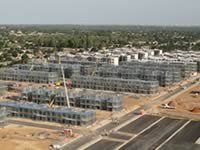 Constructing the athletes’ residence at the 2011 All Africa Games held in Mozambique was a race to the finish line, with the project team ensuring that it came it was completed in record time.
Constructing the athletes’ residence at the 2011 All Africa Games held in Mozambique was a race to the finish line, with the project team ensuring that it came it was completed in record time.
A South African company, Vela Steel Building Systems, has been part of the technical solution to the fast-track construction of accommodation for athletes involved in the 10th All Africa Games in Mozambique in September this year.
“The biggest challenge of this project – which will house most of the 6 500 competing athletes (from 48 countries) – has been its extremely tight construction time frame,” says Brent Harris, managing director of Vela.
“This was brought about by Mozambique stepping into the beach to host the Games after the original host, Zambia, withdrew on economic grounds – a decision which effectively halved the normal four-year preparation cycle,” he adds.
Located in Zimpeto, a suburb of Mozambique’s capital city, Maputo, the Athletes Village will provide 848 apartments in a configuration of 27 four-storey buildings. Each of the apartments will consist of three bedrooms, two full bathrooms, living room, dining room, kitchen and front and rear verandas – a total living space of almost 100 000sqm.
“Given the sheer scale of the project, and the extremely tight deadline, the main contractor – a consortium of Mota-Engil and Soares da Costa – decided to use the Worthington Construction (USA) method of Cold Form Steel (CFS) framing as the structural system on the project,” says David van Zyl, operations director of Vela.
“This provided the speed, efficiency, strength and innovation required not only to meet the project deadline, but also to produce a high quality end product in the process,” he adds.
Much of the cold form (or cold rolled) steel for the project was supplied by Vela – a specialist in alternative building systems – by way of road hauls from Johannesburg to site.
“By using load bearing CFS framing members (wall studs and floor joints) the project
took advantage of steel’s greater strength-to-weight ratio, compared with traditional construction methods, such as poured-in-place concrete,” says van Zyl.
“The Worthington Construction Group’s framing system incorporates into the structure innovative efficiencies in time, resources and engineering.
“Furthermore, the use of as lightweight a structure as possible provides the necessary strength and ductility to survive a seismic event with no catastrophic failures. By comparison, the weight of a concrete structure would have imposed significantly greater base share on the foundations,” says van Zyl.
The floor system is ledger-framed (rather than traditional platform-framed), which eliminates fire-blocking requirements. It also reduces time on the installation of floor-to-floor shear connections and on layout for the floor above.
Van Zyl says each floor is sheathed with a galvanised metal deck, which “allows MEP trades to rough in all of their work before the self-levelling floor underlayment (3500 psi) is poured.”
“The unique floor underlayment is half the weight of structural concrete – thus reducing floor system dead loads and allowing for a lighter foundation. The floor assembly also eliminates shoring and core drilling, thus allowing MEP trades to move more quickly from floor to floor,” says van Zyl.
“Another advantage of CFS framing is the adoption of the technique of panelisation of the load-bearing interior and exterior wall panels – which accelerates the construction process and reduces the variability and guesswork (while increasing the level of quality).
“In a nutshell, the advantages in speed, efficiency, strength and innovation have been the driving forces that enabled the Athletes Village Project to meet its deadlines without compromising the high quality end product,” van Zyl concludes.
The work force on the project was predominantly made up of South Africans and Mozambicans, some of whom were trained by experienced carpenters from the USA, China and Portugal on the new framing technology.
Once the Games are over, and the athletes have gone home, the Village will be converted into housing for local residents of Zimpeto.
